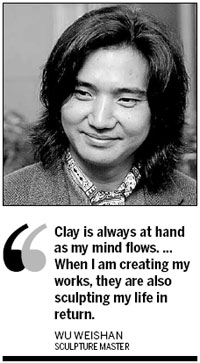
|
Above: Confucius's meeting with Lao Tzu. The "immortal poet" Li Bai. Confucius is a towing mountain of Chinese culture. Provided to China Daily |

Wu Weishan says clay is his most intimate friend, Xie Chuanjiao discovers
Many Chinese artists have now attained international recognition but few have gained a level of respect shown to sculpture master Wu Weishan.
His works have been exhibited and collected across the world. United Nations Secretary-general Ban Ki-moon said his sculptures "embody not just the soul of a nation but of all humanity". Queen Beatrix Wilhelmina Armgard of The Netherlands praised the historical notable characters he sculpted as "walking out of a 5,000-year history". Scholar Ji Xianlin said: "The sculptural arts of China entered a new era led by Wu Weishan."
The 51-year-old sculptor from East China's Jiangsu province is known for his exceptionally expressive portrait sculptures, which include works of more than 500 historical and cultural notable people as well as ordinary folk.
His portrait of ancient philosopher Lao Tzu won a gold medal at the 2012 Louvre International Art Exhibition.
"The traditional Chinese culture includes a wide range of virtues such as humanity, faith, honesty and tolerance," Wu said. "Those sculptures reflect the ideas and philosophy that resonates throughout history which are also needed in today's world."
In 2003 Wu won the Pangolin Award of the British Society of Portrait Sculptors for his work "The Sleeping Child", which enabled him to become a member of the Royal British Society of Sculptors.
"It was modeled during a visit to a friend's house," Wu recalled. The friend's child was unwell and had been crying for most of the day. Later the baby fell asleep with his mouth open. Wu promptly sculpted the memorable image.
"The work reminds people of their own childhood and brings back sweet memories," said Wu. "It also reflects the universal feeling that children are innocent and have no preconceived ideas about culture."
His most cherished work is the group sculptures for the Nanjing Massacre Memorial Hall, which were completed in 2007.
The artist said he felt a responsibility to reflect the calamity caused on the Chinese people by the Japanese invasion and to convey the values of peace and dignity.
One of the group sculptures is "The Last Drop of Milk". It depicts the true story told by Chang Zhiping, a massacre survivor who witnessed his baby brother taking the last milk from the breast of his dying mother. Another piece called "The Monk" depicts a monk with his eyes closed praying for the souls of those killed.
Born into a family of calligraphers, Wu developed an interest in the arts during his childhood. It was not until he began to study at Wuxi Municipal Institute of Arts and Crafts in Jiangsu province that he formally started his sculpting career.
"Although the school was small and unknown at the time, I was lucky enough to learn at the highest level from several of the best folk artists in China," Wu said, adding he was grateful to his alma mater.
"The folk arts are full of the wisdom of Chinese people, which inspired the creativity in my sculpture."
|
|
|
| Crystal clear | Brush with history |